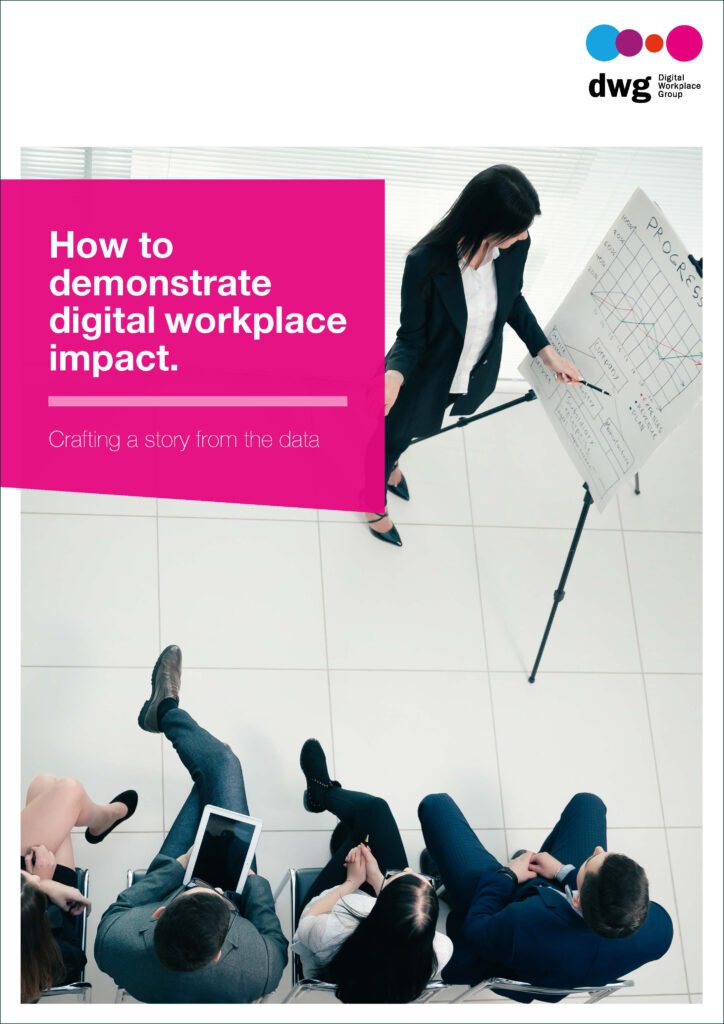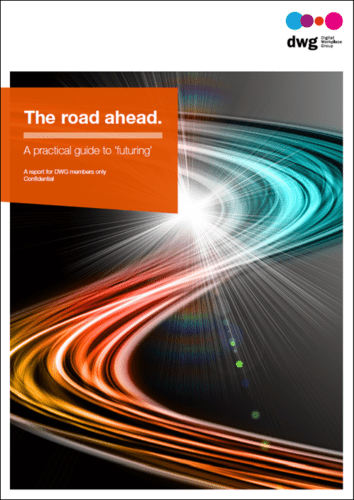How to demonstrate digital workplace impact
As DWG CEO Nancy Goebel highlights in her 2023 predictions, recessionary and inflationary pressures mean that digital workplace teams need more than ever to demonstrate tangible impact on the employee experience. Not to do so risks digital workplace initiatives once again being subject to the ebb and flow of funding and leadership attention, at worst leading to a return to little more than ‘keeping the lights on’.
Crafting a digital workplace impact story
In new research from DWG – available to download for free – we explore how digital workplace teams can embrace these challenges and craft a digital workplace impact story for now and the future. Doing so means ensuring that, as we continue to emerge into the post-pandemic world, the digital workplace doesn’t get demoted from the strategic asset status it has so recently gained in many organizations. More than ever, digital workplace teams need to position themselves to become even more advanced players, making a compelling case for the impact that ongoing attention and investment in the digital workplace can have.
What award winners do differently
Demonstrating impact is one of the criteria for DWG’s Digital Workplace and Modern Intranet of the Year awards. It is an area the judges routinely mark down as being insufficiently compelling or well-evidenced. Where data is submitted it is often ‘just numbers’, usually adoption metrics, with no sign of the KPIs teams are trying to achieve or how the measures tie into wider strategy and vision. Even where decent metrics are in place, it is rare to see them woven into a cohesive and compelling impact story. There is reporting on measurement, but this is not framed in such a way as to demonstrate impact.
By contrast, among award winners we see practices such as:
- having a broad measurement programme that encompasses the increasingly wide array of metrics available to them in the digital workplace, collated and translated into indicators of productivity, cost and even well-being
- professionalizing the team’s metrics capability by upskilling or bringing in new talent to help collate, analyse and report on the data available to them
- combining a range of quantitative and qualitative insights into an easy-to-consume, manipulable format in metrics dashboards.
At The Coca-Cola Company, for example, by integrating data from multiple tools – such as MS Graph, Synapse, Adobe Insights and Viva Insights – the digital workplace team is able to tell a cohesive story around the digital employee experience. While at SAP, the team has looked at employee ‘journeys’, such as parenthood, measuring satisfaction levels before and after interventions to enhance these journeys and providing powerful data to demonstrate impact.
Building an impact framework
Building an impact framework at the outset of the initiative can help to ensure that the desired outcomes are clear and that you know when they have been achieved – or when a course correction is needed. Formal evaluation methodologies such as Theory of Change (ToC) have been enthusiastically (and successfully) adopted and developed by programme teams worldwide to show the impact of initiatives. This is particularly true in not-for-profit, international development and government sectors, where impact can be harder to demonstrate.
A ToC provides the big picture by describing the outcomes and impact that you want to achieve with your programme, as well as how and why you think change will happen. This includes the inputs (resources) and the activities and outputs needed to make the change happen, and how these link to desirable outcomes and impact.
In essence it says:
“Impact X will happen as a result of change Y brought about by Z resources and activities.”
In the report, we explore this concept in depth, gaining insights from impact and evaluation specialist, Sara Dunn, who emphasizes the practical nature of the tool and how it can be deployed in many different contexts.

7 steps to create a Theory of Change
Here’s a summary of the 7 steps that are set out in more detail in the report to create a ToC for your digital workplace:
1. Make a diagnosis. The first step is to understand the problem(s) you are tackling. This is where you gather new and existing research inputs from activities such as employee surveys, interviews, focus groups and benchmarking to analyse the employees’ problems, wants and needs, as well as barriers/opportunities etc.
2. Articulate the impact. This is where you think about and articulate the impact that you want to have for the organization and employees with your digital workplace initiative.
3. Work backwards to outcomes. Outcomes could include changes among your target audience in knowledge/skills, attitudes and behaviours: what will they be doing differently in a week, month or year?
4. How to achieve outcomes/impact. This is where you think about what you are going to do to achieve the outcomes and impact you have articulated in Steps 2 and 3. It isn’t the detailed project plan but it does describe the key features of the activities you will undertake, how and when they will be delivered, who will deliver them, and how you will let people know and bring them with you.
5. Visualize the ToC. At this stage it can be really helpful to synthesize all of the outputs from previous steps into a visualization of your ToC. Creating a one-page diagram of the change is a great discipline, making you think hard about what to include and leave out, and prompting further reflection. It is also an important tool for communicating the change to key stakeholders.
6. Look outwards. Here you look outwards to focus on what you need others to do to support the change and how they might help or hinder the impact you want to make. This can involve mapping stakeholders as well as considering any contextual factors that may affect your ToC.
7. Stress-testing. It’s time to step into the shoes of your most critical stakeholder and most reluctant end user. How would they pick holes in your programme or initiative and the impact you claim it will have? What would they question, doubt and challenge? Doing this will help you to see where your ToC is weak or unclear, as well as preparing you for concerns you may encounter outside of the immediate team.
For detailed steps and templates for creating your ToC, as well as tips on how to use storytelling techniques to bring it alive for stakeholders, download the free research report.
Download the free research report
How to demonstrate digital workplace impact:
Crafting a story from the data
Get access to 100+ other best practice digital workplace reports
This report forms part of DWG’s best practice Research Library of 100+ reports covering key areas such as strategy and governance, personalization, user experience and change management for intranets and digital workplaces. Find out what else is in the library and new research that’s coming up. Contact us to learn how to gain access to this library via DWG Membership.
Categorised in: Metrics & measurement, Research reports

